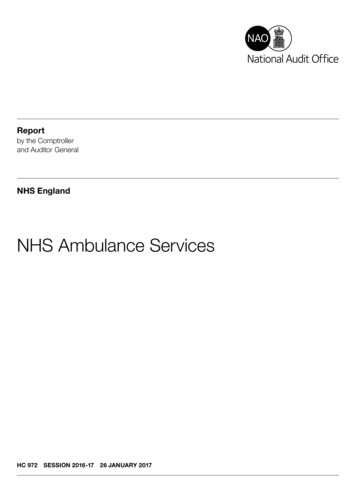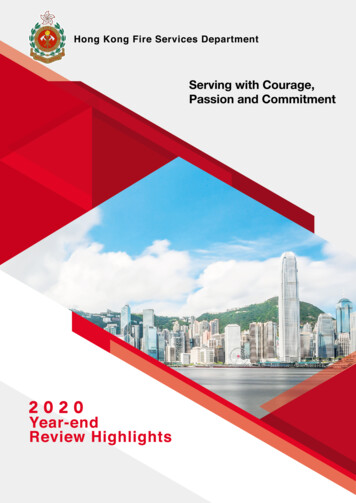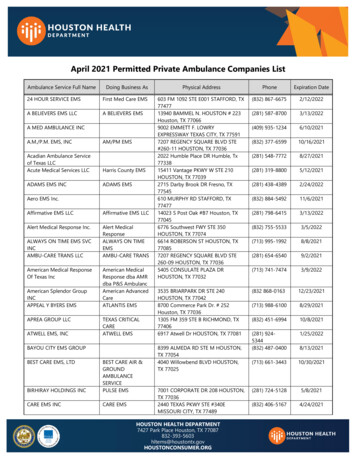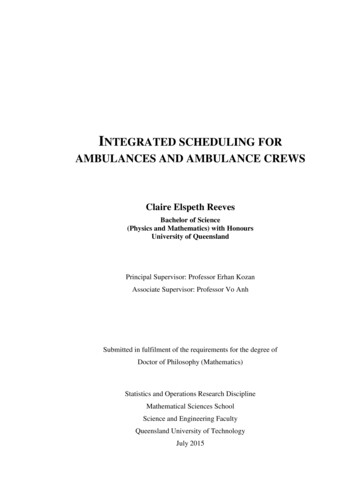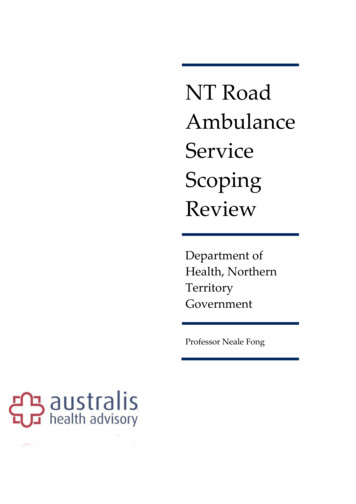
Transcription
NT RoadAmbulanceServiceScopingReviewDepartment ofHealth, NorthernTerritoryGovernmentProfessor Neale FongPerth 2017
This page has been intentionally left blankNorthern Territory Government, Department of Health NT Road Ambulance Service Scoping ReviewPage i
Letter to the Minister for Health1 December 2017The Hon Natasha Fyles, MLAMinister for Health, Attorney General and Minister for JusticeParliament HouseDarwin NT 0800Dear MinisterNT Road Ambulance Service Scoping ReviewI thank you for the opportunity to provide this report on the Scoping Review.I wish to thank officers of your department and all the stakeholders involved in someway in road ambulance service and its many interfaces, for their generous andpositive support throughout the consultation process. The scale of response toinvitations to meet was commendable.The NT does have significant challenges when it comes to providing a quality,responsive and equitable service for its population.Notwithstanding these challenges, the road ambulance service functions well. It istime however, to move from functioning to performing. There are many aspects thatrequire significant reform. They are whole of health, and specific to the majorprovider, St John Ambulance NT. These findings and suggested reforms are outlinedin the report.Overall the actual clinical and administrative staff from all the stakeholderorganisations and the community volunteers involved in ambulance services providehigh quality care.Organisational changes are recommended, and I look forward with a great deal ofoptimism to all stakeholders coming together to discuss the issues outlined, andmoving quickly to support the enabling of the recommendations.I commend the Review to you.Yours sincerelyDr Neale FongIndependent ReviewerNT Road Ambulance Service Scoping ReviewNorthern Territory Government, Department of Health NT Road Ambulance Service Scoping ReviewPage ii
AcknowledgementsI would like to acknowledge and thank the Review’s support team of NicoleCameron, NT Department of Health and Donelle Rivett, Paxon Group who effectivelymanaged the administration requirements of the review, as well as assisting withresearch and preparation of this Report. Ms Ashlea Ladd from SJAANT was also ofgreat assistance in providing information from that organisation for the review. Thework of the Consultative Committee chaired by former Deputy CEO NT Health JanetAnderson PSM was also of valuable assistance.Professor Neale FongIndependent ReviewerNorthern Territory Government, Department of Health NT Road Ambulance Service Scoping ReviewPage iii
Table of ContentsLetter to the Minister for Health . iiAcknowledgements . iiiExecutive Summary . vii12Introduction .11.1Background and Definition of Ambulance Services .11.2Scope of Review .21.3Review Governance – Consultative Committee .31.4Review Method .31.5Structure of the Report .4NT Ambulance Service Model .52.1NT Population Distribution . 52.2NT Pre-Hospital and Emergency Ambulance Service Providers .52.3St Johns Ambulance Australia NT Inc. (SJAANT) .62.4NT Rural and Remote Emergency Patient Transport .82.5NT Department of Health – Patient Transport Services .92.6Other Non-Government Providers of Patient Transport Services . 102.7NT Road Ambulance Model Funding . 112.8Road Ambulance Activity Statistics and Trends . 112.9NT Communications and Coordination of Dispatch System . 142.10 Half-way Meets as Part of the Road Ambulance Response . 162.11 Aeromedical Services . 1734Ambulance Services in Australia . 183.1Introduction . 183.2Ambulance Services Legislation . 183.3Service Delivery Models . 193.4Demand for Ambulance Services . 223.5Funding for Ambulance Services . 223.6Ambulance Services’ Structure . 233.7Ambulance Services’ Clinical Benchmarking . 25Key Issues and Themes – Part A General and Territory Wide Issues . 284.1Factors Influencing Demand and Management of Demand . 284.2Call Centre, Communications and Coordination of Dispatch . 35Northern Territory Government, Department of Health NT Road Ambulance Service Scoping ReviewPage iv
56784.3Half-way Meets . 384.4Homelands . 384.5Aeromedical Interface . 394.6Palmerston Regional Hospital – Patient Transport Services . 424.7Legislation and Regulation . 43Key Themes and Issues – Part B Issues Specific to SJAANT . 455.1Ambulance Workforce . 455.2Leadership and Management . 485.3Health and Wellbeing . 495.4Clinical Governance . 545.5Training and Professional Development . 565.6Equipment, Technology and Infrastructure . 595.7Contract, Financing and Funding . 60Findings . 636.1Part A – General and Territory-Wide Issues . 636.2Part B – Issues Specific to SJAANT . 68Recommendations . 737.1Part A – General and Territory Wide Issues . 737.2Part B – Issues Specific to SJAANT . 76Acronyms . 80Appendices . 82Appendix A - NT Road Ambulance Service Scoping Review - Terms of Reference . 83Appendix B – Consultative Committee Membership . 85Appendix C – Stakeholder Consultation . 86Appendix D - DoH/SJAANT Contract Annexure H – Remote Area Referral ResponsePolicy and Guidelines – TEHS. 91Appendix E - DoH/SJAANT Contract Annexure I – Remote Area Referral ResponsePolicy and Guidelines – CAHS. 92Appendix F - DoH/SJAANT Contract Annexure J – TEHS Rotary Activation Protocol . 93Northern Territory Government, Department of Health NT Road Ambulance Service Scoping ReviewPage v
LIST OF FIGURESFigure 1 - NT Road Ambulance Service Scoping Review method. 3Figure 2 - Location of PHC Clinics by Provider in TEHS . 8Figure 3 – Location of PHC Figure 3 - Location of PHC Clinics by Provider in CAHS . 9Figure 4 – Ambulance Attendances by Code . 13Figure 5 – Call Volume and ECC Percentage . 14Figure 6 - Reported ambulance incidents, responses and patients, per 1000 people, 2015-16 . 22Figure 7 - Revenue of ambulance service organisations (2015-16 dollars) ( million) (2013 –2016) . 23Figure 8 - Cardiac survival rates (%) by jurisdiction for 2015/16 . 25Figure 9 - Percentage of patients who report a clinically meaningful pain reduction . 26Figure 10 - Proportion of ambulance users who were satisfied or very satisfied with theambulance service, 2016. 27Figure 11 - Ambulance demand influencers . 29Figure 12 - Continuous Service - Rotary Wing Asset 2016-2017 . 41Figure 13 - Lost Time Injuries - 2012 – 2017 (Days and LTIFR) . 54LIST OF TABLESTable 1 - Delivery and scope of activity of ambulance service organisations . 1Table 2 – Service Structure for SJAANT . 7Table 3 – Source of SJAANT ambulance service organisation revenue ( ’000) . 11Table 4 - Number of ambulance trips NT 2009/10-2013/14 . 12Table 5 – Ambulance Attendance by Code – Annual Growth . 12Table 6 - Incidents by Station/Centre . 13Table 7 - State and Territory Ambulance Service - Legislation . 19Table 8 – Summary Australian Ambulance Service Models. 20Table 9 – Non-Emergency Patient Transport (NEPT) Service Models by State/Territory . 24Northern Territory Government, Department of Health NT Road Ambulance Service Scoping ReviewPage vi
Executive SummaryThe management of road ambulance services is a complex business with numerousstakeholders and with very high community and patient expectations. In theNorthern Territory (NT) the road ambulance service, which includes emergencyresponse and patient transport, call taking, triage, dispatch and retrieval, overallfunctions well.However, though the service is functioning satisfactorily, it now needs to move tonew stage of performance excellence. A functioning model of service can often be aresult of individuals’ extraordinary commitment to ‘make things work’, rather thanthrough a planned, coordinated and well implemented system. There are numerousareas the Review has found that require significant improvement and greatercollaboration.The Review did find that there is an abundance of ideas, thinking and enthusiasm tomake change, but the stakeholders in the sector are overly focused on organisationalself-interest, rather than achieving the best outcome for Territorians. There is a greatneed for closer partnerships between the major road ambulance provider and thehealth system (hospitals and health clinics) and other medical retrieval providers.Many examples of poor communication and a lack of leadership and goodwill toachieve better outcomes were identified.The Review was concerned to hear from ambulance officers and senior managementin SJAANT that organisational culture change was long overdue, and that leadershiphad not addressed key issues for improvement of its service. This pertained especiallyto workload management issues, training, career pathways and opportunities andstaff health and wellbeing.However, recognition should be given to some significant change initiatives led bySJAANT, particularly with respect to clinical governance, over the last eighteenmonths, to bring about service and corporate improvements. Overall ambulanceofficers have seen this as positive change.The Department of Health (DoH) as the contract manager, has developed a muchimproved framework for contracting with SJAANT through the current contract(2016-2021), characterised by moving from a model of ‘granting’ money, to a contractfor services model, with key performance indicators (KPIs) and monitoringrequirements. However, this too requires more robust engagement and sophisticatedmonitoring, with greater direct involvement from Health Service Providers.Involvement of health service providers (HSPs) in future development, managementand monitoring of the SJAANT Contract is a priority, particularly with the need toensure collaborative and consistent approaches to clinical protocols and complexdecision making relating to dispatch coordination.Legislation should be brought into the NT Parliament to regulate ambulance serviceprovision, thus safeguarding this aspect of the NT health service for all Territorians.It is Reviewer’s opinion that many of the concerns and issues that have beenidentified through this Review can be remedied by diligent and collaborativeNorthern Territory Government, Department of Health NT Road Ambulance Service Scoping ReviewPage vii
discussions and negotiations between all the relevant stakeholders in the currentstructural model.It is not the Reviewer’s opinion that bringing the management of the road ambulanceunder the Department of Health is the right solution to address all the concerns andissues raised by the Review. However, the key stakeholders, and SJAANT as themajor provider, should all be required to make swift changes to address many of thefindings and recommendations of this Review, and be held to strict account on theirimplementation.Northern Territory Government, Department of Health NT Road Ambulance Service Scoping ReviewPage viii
1 Introduction1.1Background and Definition of Ambulance ServicesAmbulance services serve as an integral part of the health system and have a criticalrole in preparing for, providing and enhancing: emergency and non-emergency pre-hospital and out-of-hospitalpatient care and transport;inter-hospital patient transport including the movement of criticalpatients;specialised rescue services;the ambulance component of multi-casualty events; andthe community’s capacity to respond to emergencies.1 Ambulance service organisations are the primary agencies involved in providingservices for ambulance events. State and Territory governments provide ambulanceservices in most jurisdictions except for WA and NT where, St John Ambulance isunder contract to the respective governments as the primary provider of ambulanceservices (Table 1).In a limited number of cases, other organisations provide specialist services such asaeromedical transport for emergencies.Table 1 - Delivery and scope of activity of ambulance service organisations 1State/TerritoryUmbrella DepartmentAmbulance Service Provider(s)NSWNSW HealthNSW Ambulance – a division of the Ministry ofHealth reporting to the Minister for HealthVICVictorian Department ofHealth and HumanServicesAmbulance Victoria — a separate statutory bodyreporting to the Minister for Ambulance ServicesQLDQueensland Departmentof HealthQueensland Ambulance Service – a division of theDepartment of Health.WAWA Department of HealthSt John Ambulance WA – an incorporated not forprofit organisation under contract to the WAGovernment.SASA HealthSA Ambulance Service – an incorporated entityunder the SA Health Care Act.TASDepartment of Health andHuman ServicesAmbulance Tasmania – a statutory service of theDepartment of Health and Human Services.Steering Committee for the Review of Government Service Provision (SCRGSP) (2017) Reporton Government Services 2017, vol. E, Health, Productivity Commission, Canberra1Northern Territory Government, Department of Health NT Road Ambulance Service Scoping ReviewPage 1
1.2State/TerritoryUmbrella DepartmentAmbulance Service Provider(s)ACTACT Emergency ServicesAgency (Justice andCommunity SafetyDirectorate)ACT Ambulance Service – one of four operationalservices that comprise the ACT Emergency ServicesAgency, Justice and Community Safety Directorate(the other operational services are the ACT Fire andRescue, ACT Rural Fire Service and ACT StateEmergency Service). The Department reports to theACT Minister for Police and Emergency Services.NTNT Department of HealthSt John Ambulance NT – an incorporated not forprofit organisation under contract to the NTGovernment.Scope of ReviewThe Minister for Health, the Hon Natasha Fyles MLA announced on 8 February 2017an independent review of the NT road ambulance services to consider and gain anunderstanding of the future of road ambulance services in the NT.For the review process, the Minister committed to working with the current roadambulance service providers, St John Ambulance Australia NT Inc. (SJAANT) andUnited Voice, the key union representing paramedics, patient transport andcommunications employees.The NT Road Ambulance Services Scoping Review (Review) was established to: Identify contemporary best practice in the delivery of roadambulance services by comparison against road ambulance serviceselsewhere that operate in a context relevant to the NT;Consider the need for future regulation of road ambulance servicesin the NT;Identify future workforce requirements for a contemporary roadambulance service in the NT including the training, developmentand retention of the ambulance services workforce; andExamine the interface between road ambulance services and otherhealth emergency services to maximise the efficiency andeffectiveness of emergency responses including the interface withaeromedical services.While aeromedical patient emergency and transport services were not in scope, theinterface between road ambulance and aeromedical services was considered in thereview due to their operational interdependence.The NT Department of Health (DoH) contracts aeromedical services through the RoyalFlying Doctor Service (RFDS) in the Central Australia region, and CareFlight Limitedin the Top End region.The Review’s Terms of Reference approved by the Minister for Health (July 2017) areavailable in Appendix A.Northern Territory Government, Department of Health NT Road Ambulance Service Scoping ReviewPage 2
1.3Review Governance – Consultative CommitteeDr Neale Fong, the independent reviewer, led the Review with governance oversightprovided by the Review Consultative Committee. The Review ConsultativeCommittee was chaired by Ms Janet Anderson, former Deputy Chief Executive,Department of Health with member representation from: St John Ambulance Australia NT (SJAANT)United VoiceTop End Health Service (TEHS)Central Australian Health Service (CAHS)Department of Health ((DoH)The full list of Members is available in Appendix B.1.4Review MethodThe Review Consultative Committee and Independent Reviewer jointly agreed themethod and conduct of the review prior to commencement of the review. The intentof the review was to provide the NT Government with considered advice andidentification of strategic directions for road ambulance services as per the Terms ofReference.A four-stage process for the review was utilised consisting of desktop reviews,data/benchmarking analysis, and consultation. Figure 1 provides a high-leveldescription of the method implemented.Figure 1 - NT Road Ambulance Service Scoping Review methodStage 1 - DesktopReview Confirm scope,parameters andassumptions. Confirm stakholderconsultation. Informationrequirements. Deliverblesagreement.Stage 2 - Research Describe currentservice model. Servicebenchmarking. Professionaldevelopment,governance, andsafety performancemetrics. Legislation andregulation models. Funding models, Careerdevelopment.Stage 3 Consultation Stakeholderconsultation andsite visits. Identification ofstrategic andoperational issues(geographic,workforce). Environmental(market place)implications.Stage 4 - ReviewReport Identification of keyissues. Recommendations.The Independent Reviewer met with over 140 individuals across the regions andattended sites including SJAANT’s centres and sub stations, hospitals, primary healthcentres, and Aboriginal community controlled health organisations (ACCHO) acrossthe NT. In addition to consultations, the Independent Reviewer received a smallnumber of written submissions.A full list of individuals and organisations consulted by the Independent Reviewer isavailable in Appendix C.Northern Territory Government, Department of Health NT Road Ambulance Service Scoping ReviewPage 3
In advance of consultation meetings, the Independent Reviewer was provided with aconsiderable amount of documentation and in particular from SJAANT.1.5Structure of the ReportThis report provides information on the findings and recommendations of theIndependent Reviewer as laid down in the Terms of Reference. Chapter 1 introduces ambulance services scope and methodologyfor the review.Chapter 2 provides an overview of the current NT road ambulanceservice and interface with other health care providers andaeromedical retrieval services.Chapter 3 provides summary of other ambulance services inAustralia and identifies key benchmarking data for comparisonwith NT road ambulance services.Chapter 4 discusses the general themes identified by theIndependent Reviewer emerging from consultations undertakenand submissions received.Chapter 5 discusses the SJAANT specific themes identified by theIndependent Reviewer emerging from consultations undertakenand submissions received.Chapter 6 provides discussion of the Independent Reviewer’s keyfindings.Chapter 7 provides a list of recommendations from the review.Northern Territory Government, Department of Health NT Road Ambulance Service Scoping ReviewPage 4
2 NT Ambulance Service Model2.1NT Population DistributionThe NT’s population is spread across a diverse range of locations, from urban centres2in Darwin, Alice Springs and Palmerston, to remote and very remote locations. Thedistribution of the population is an important issue as it influences policies aroundservice provision, economic performance and the socio-economic wellbeing ofcommunities.The 2016 NT estimated population was 245,000 with 59 percent of the populationresiding in the urban area of Darwin and Greater Darwin (Palmerston and Litchfield),19.5 percent of the population reside in remote areas and 21.5 percent of thepopulation residing in very remote areas.3The Aboriginal and Torres Strait Islander (hereafter referred to as Aboriginal) residentpopulation is estimated at 74,509, approximately 30 percent of the total NTpopulation4, with the majority residing in very remote areas (58 percent) where healthstatus decreases, and higher rates of disease are reported.5The major challenges for service delivery of any type in the NT relate to geographyand distance, a dispersed population, inequitable access to infrastructure for rural andremote areas and related resource distribution. The ability to achieve economies ofscale and equity of service provision is severely hampered by these factors andcompounded when services require a higher level of specialisation and capabilitysuch as provision of first response medical care and emergency treatment, retrievaland transport.These factors influence the ability to sustain consistent and equitable service deliveryto the standard expected from a modern high performing ambulance service.2.2NT Pre-Hospital and Emergency Ambulance Service ProvidersThe NT Government through the Department of Health (DoH) contracts with anumber of pre- hospital and emergency service providers, along with other patienttransport services forming an integrated network providing Territory-wideambulance services.Road pre-hospital emergency ambulance and Patient Transport Services (PTS) in theNT are currently provided by:ABS Census data classifies the urban centre of Darwin as ‘outer regional for populationdistribution statistics.3 ABS (2017) Regional population growth Australia 2016 (cat. no 3218.00) (released 28 July2017). Canberra4 ABS (2017). Aboriginal and Torres Strait Islander population estimates 2016 - preliminary.Available: www.abs.gov.au5 NT Department of Health (2016). Northern Territory Aboriginal Health Key PerformanceIndicators Public Release Report, 2014. Department of Health, Darwin.2Northern Territory Government, Department of Health NT Road Ambulance Service Scoping ReviewPage 5
2.3SJAANT through provision of emergency ambulance road transportservices generally within a 150-kilometre radius of each NT majorurban centre defined contractually as Darwin CBD, Darwin,Palmerston, Greater Darwin Region (including Litchfield, CoxPeninsula, Finniss and Coomalie), Katherine, Nhulunbuy, TennantCreek, and Alice Springs; andA network of community-based primary health centres (PHCs)located outside the 150-kilometre radius who provide remoteemergency patient transport and first responder services usingresources of either DoH, Aboriginal Community-Controlled HealthOrganisations (ACCHOs) or Community Controlled Organisations(CCO), in concert with SJAANT and aeromedical providers.St Johns Ambulance Australia NT Inc. (SJAANT)SJAANT is the primary provider of road ambulance services in the NT. SJAANT isaffiliated with St John Ambulance Australia (SJAA). Nationally SJAA consists of eightseparate state based organisations.SJAANT has been funded by the NT Government to provide pre-hospital andemergency road ambulance (including patient transport) services since 1995. Thecurrent contract (five plus five-year option) commenced 1 February 2016 andprovided a 35 percent increase in funding to support growth and serviceimprovement. The previous contact (five plus an exercised three-year option) did notinclude growth funding or allow for additional services during the eight-year period.SJAANT is also contracted to provide communications, dispatch and coordination forall NT triple zero (000) ambulance emergency calls.Darwin has four ambulance centres located strategically in Parap, Casuarina,Palmerston and Humpty Doo, each nominally providing a base for one 24/7 (168hours a week) emergency road transport ambulance with a crew of two ambulanceofficers, (sometimes a graduate paramedic forms this crew) for a total of 712 hours perweek of emergency road transport ambulance services per centre.6In addition to pre-hospital and emergency road transport services, SJAANT providespatient transport services. Patient transport services are provided in: Alice Springs – one crew 12/7; andDarwin – one crew 24/7 and a second crew 24/2.PTS crews consist of two patient transport officers (PTO). PTOs are not required to bequalified paramedics.Table 2 summarises SJAANT’s service model, locations and resources for each centreand operational facility:An additional ‘K’ ambulance crew is rostered from 3pm to 11pm Monday to Friday (a further40 hours a week).6Northern Territory Government, Department of Health N
Queensland Ambulance Service - a division of the Department of Health. WA WA Department of Health St John Ambulance WA - an incorporated not for profit organisation under contract to the WA Government. SA SA Health SA Ambulance Service - an incorporated entity under the SA Health Care Act.
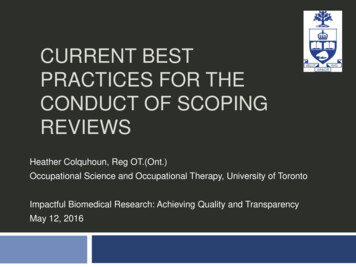
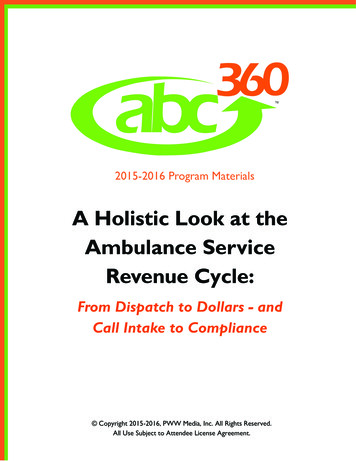
![MOH STANDARDS FOR EMERGENCY AMBULANCE SERVICE (2017) [Updated 21 Nov 2018]](/img/51/emergencyambulancestandards.jpg)
